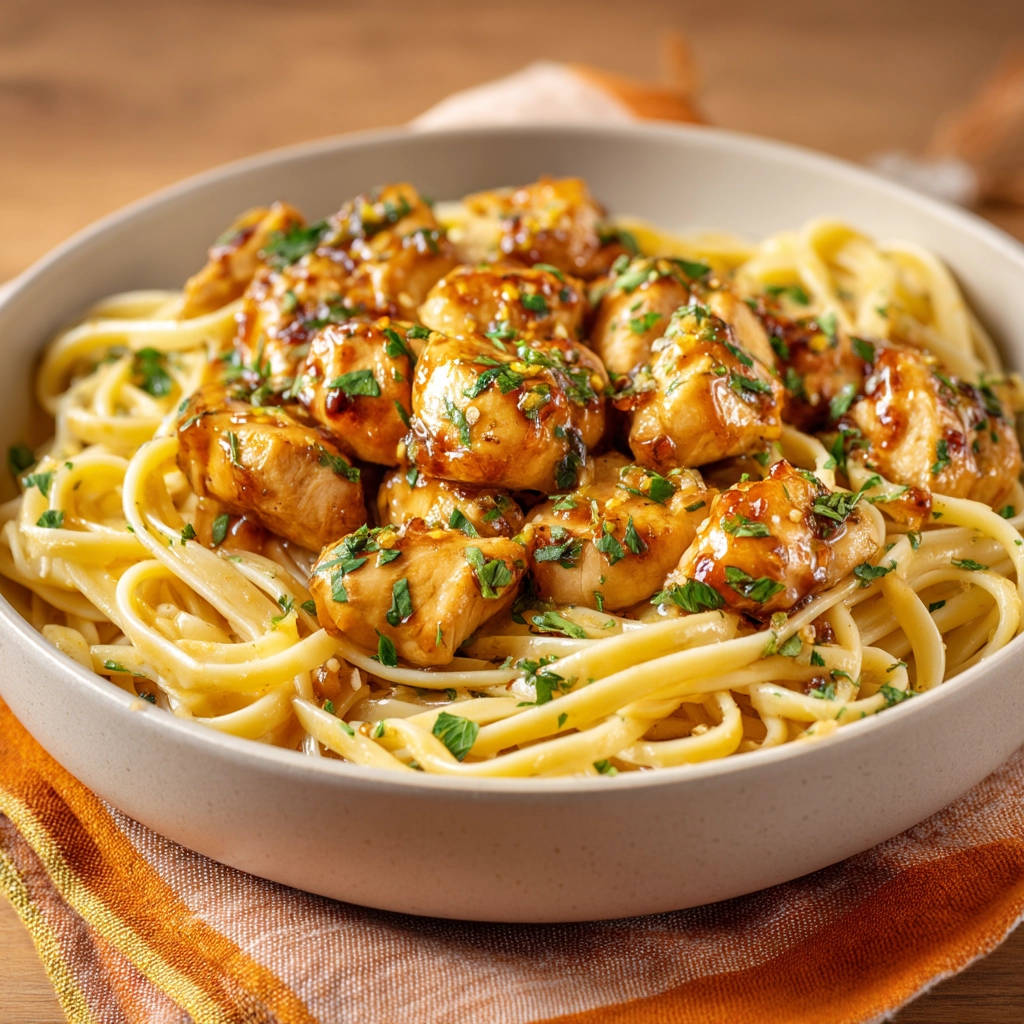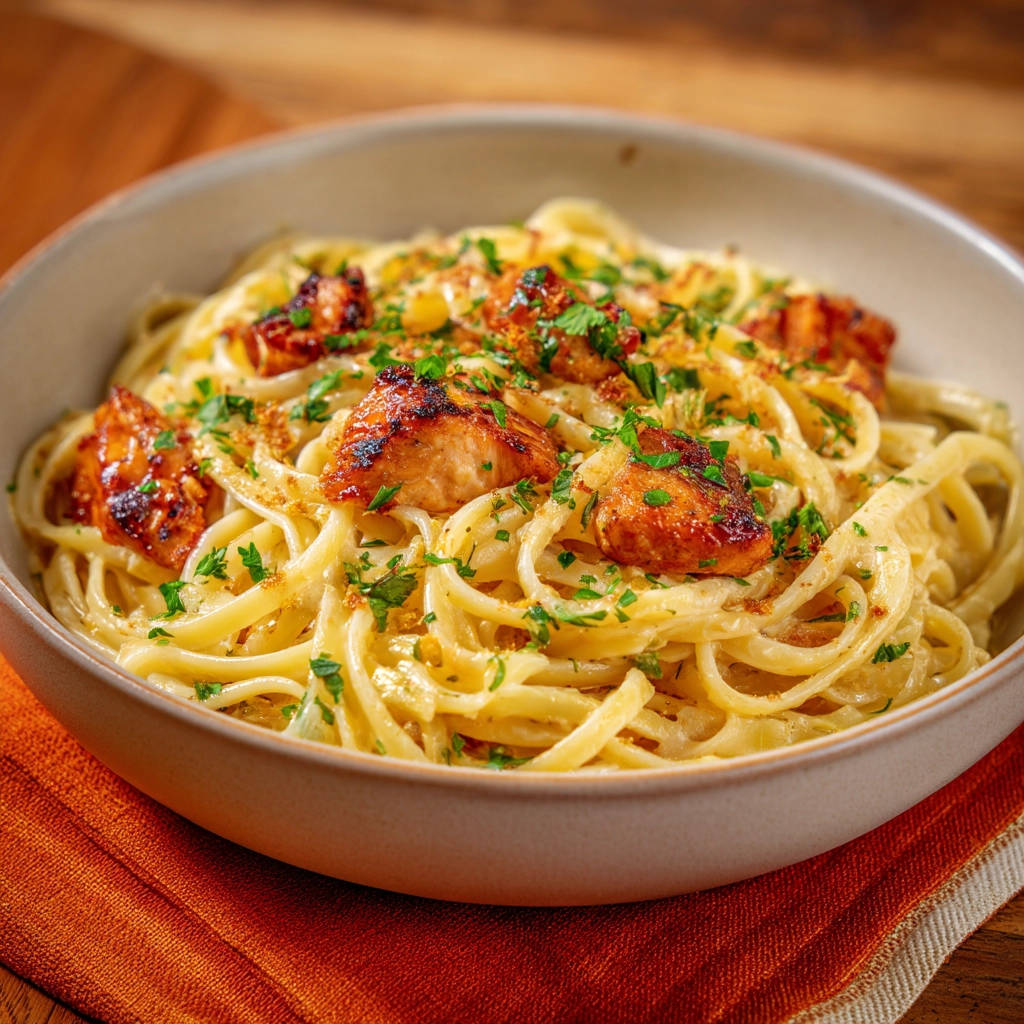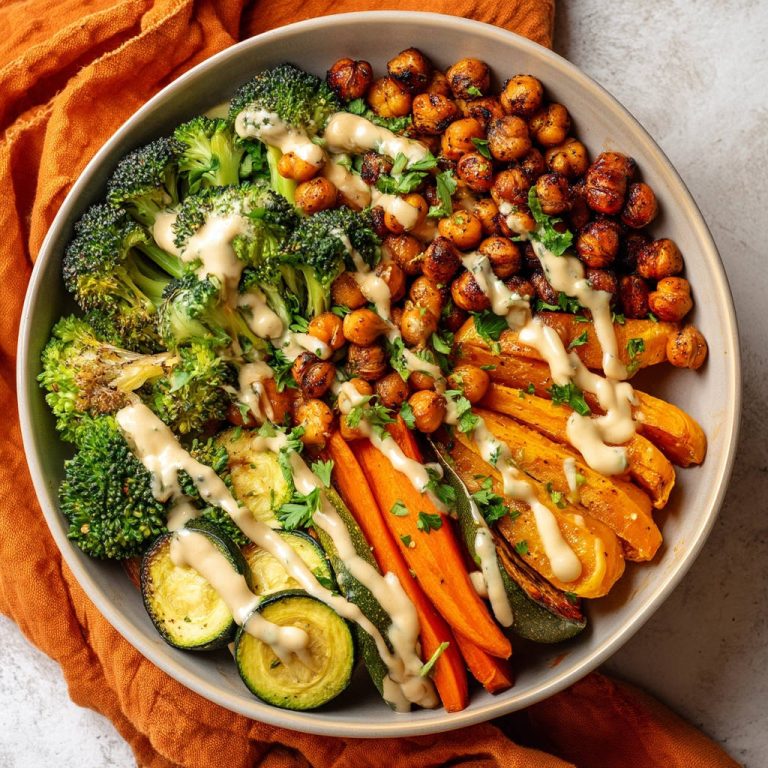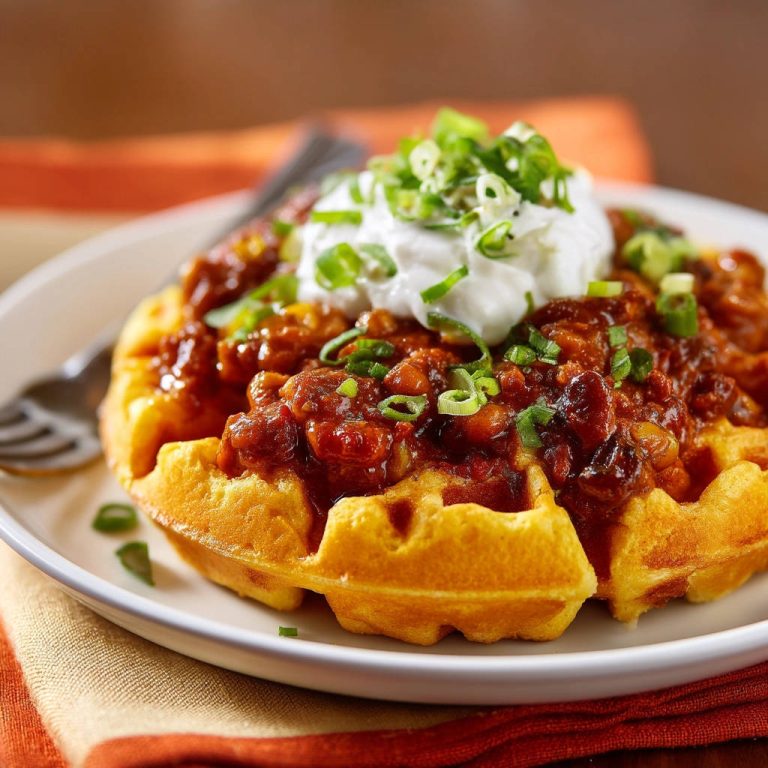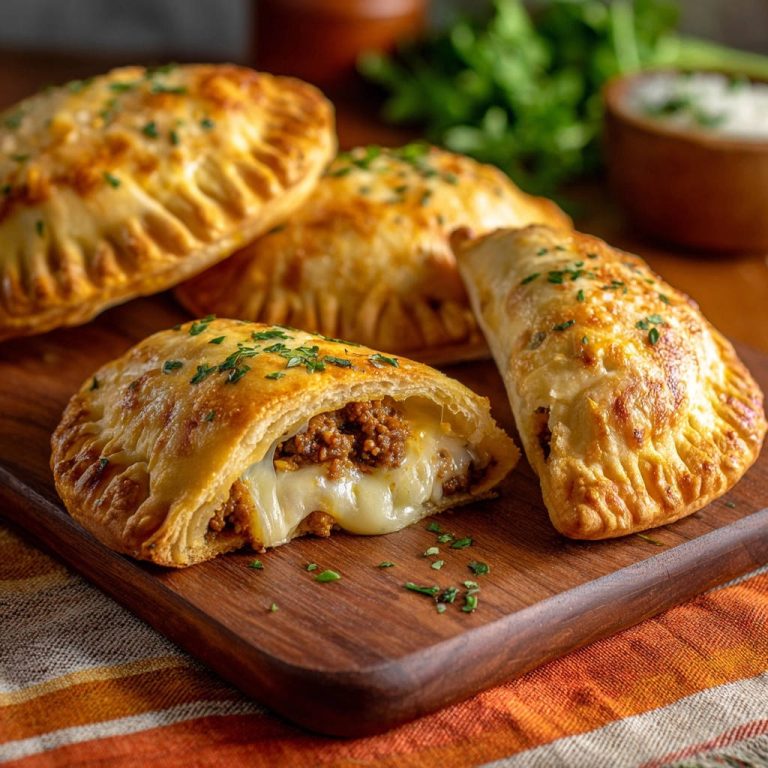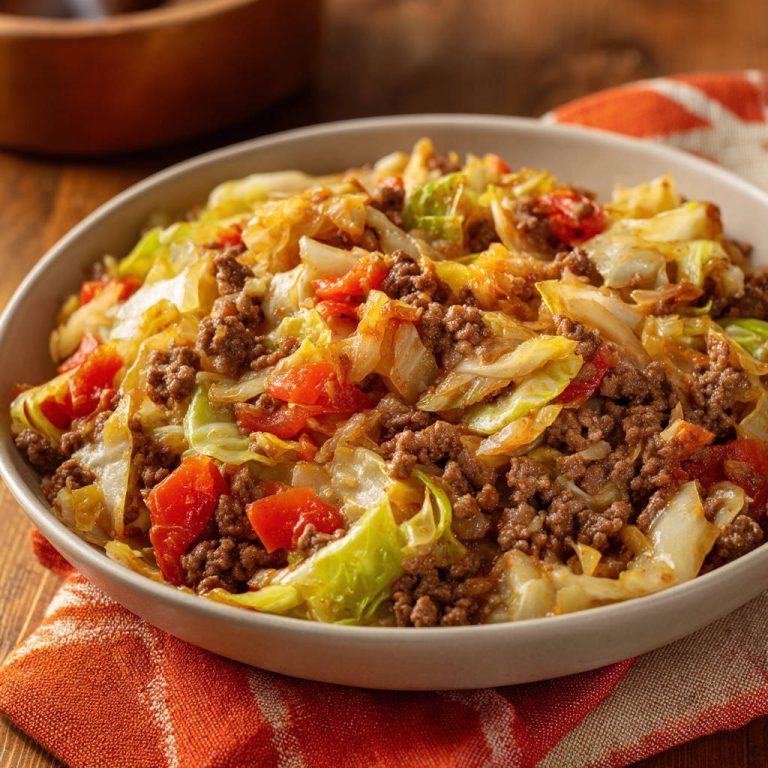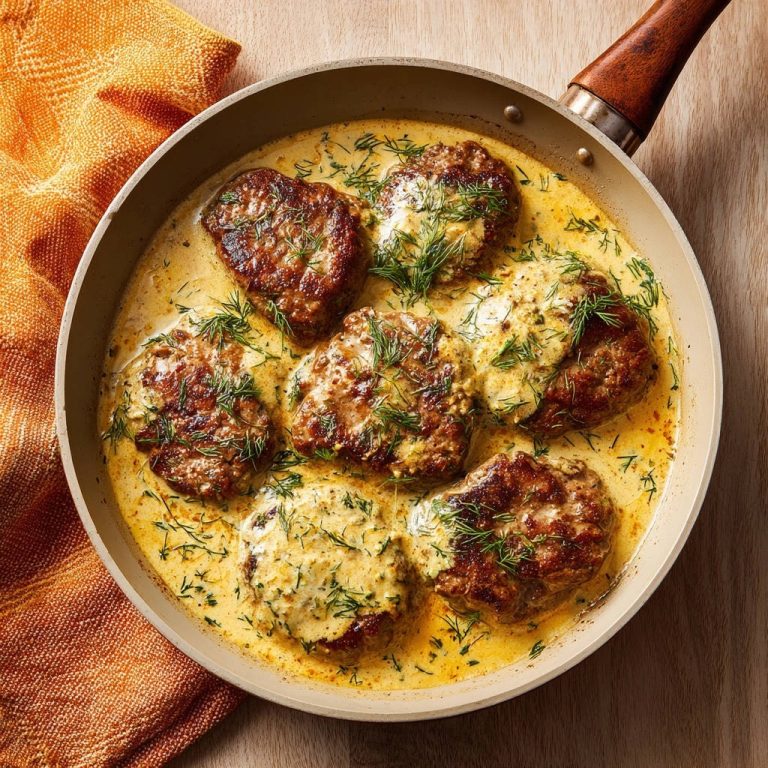Oh, friends, let’s talk about chicken pasta. It’s the ultimate comfort food, a weeknight hero, and universally loved, right? But admit it, haven’t we all been there? You make a beautiful plate of pasta, ready to dig in, only to bite into chicken that’s tough, dry, and utterly disappointing. It’s the culinary equivalent of stepping on a Lego in the dark!
I’ve been on a mission for years to conquer the dreaded dry chicken in pasta, and I’m thrilled to report: mission accomplished! This isn’t just another Garlic Herb Chicken Pasta recipe; it’s THE recipe that guarantees perfectly tender, juicy chicken every single time, coated in a rich, flavorful garlic herb sauce. No more dry chicken, just pure deliciousness that comes together faster than you might think.
Reasons This Garlic Herb Chicken Pasta is a Keeper
Why should this recipe earn a permanent spot in your dinner rotation? Let me count the ways:
- Guaranteed Juicy Chicken: I’m not kidding! There’s a simple technique that ensures your chicken stays moist and tender, even after simmering in the sauce.
- Packed with Flavor: Fresh garlic and herbs, tangy lemon juice, and savory chicken broth create a vibrant sauce that coats every piece of chicken and strand of pasta.
- Quick and Easy: From start to finish, this dish is ready in just about 35 minutes, making it ideal for busy weeknights when you crave something satisfying but don’t have hours to spend in the kitchen.
- Uses Simple Ingredients: You likely have most of the ingredients in your pantry and fridge already.
- Versatile: It’s delicious as is, but also incredibly easy to customize with added vegetables or different pasta shapes.
Ready to say goodbye to dry chicken forever and hello to your new favorite Garlic Herb Chicken Pasta?
Gathering Your Ingredients for Garlic Herb Chicken Pasta
The magic of this dish starts with quality ingredients. While the list is straightforward, let’s chat about what makes them special in this particular pasta creation and why each element plays a crucial role in achieving that perfect juicy chicken and flavorful sauce.
Our star protein is boneless, skinless chicken breasts. We’ll cut them into 1-inch cubes. Uniform size is key here for even cooking – we want every piece to finish at the same time. Seasoning simply with salt and black pepper before cooking enhances the natural flavor of the chicken and helps create a beautiful crust.
For searing and flavor development, we’re using a dynamic duo: olive oil and unsalted butter. The olive oil provides a higher smoke point for searing the chicken, while the butter adds richness and helps create that beautiful base for our garlic herb sauce. Using unsalted butter gives you control over the overall saltiness of the dish.
No garlic herb pasta would be complete without plenty of garlic! We’re using four cloves, minced. Fresh garlic is essential for that pungent aroma and flavor that infuses the sauce. Make sure it’s minced finely so it distributes evenly.
The sauce base comes from chicken broth and fresh lemon juice. Chicken broth adds savory depth and helps build a pan sauce from those delicious browned bits left behind by the chicken. Fresh lemon juice is a game-changer – its acidity brightens the entire dish, balances the richness of the butter, and lifts the flavors of the garlic and herbs. Don’t skimp on the fresh squeeze!
Fresh parsley is our chosen herb for its vibrant, slightly peppery flavor and beautiful green color. Chopped fresh parsley is added right at the end to preserve its brightness. You could certainly experiment with other fresh herbs too!
Finally, we need pasta! Linguine or fettuccine are called for, and their flat, wide surface is excellent for holding onto that glorious garlic herb sauce. However, feel free to use your favorite pasta shape – penne, rotini, or even angel hair would work, though cooking times may vary slightly.
Here’s the full list of what you’ll need:
- 1 pound boneless, skinless chicken breasts, cut into 1-inch cubes
- Salt, to taste
- Black pepper, to taste
- 2 tablespoons olive oil
- 4 tablespoons unsalted butter
- 4 cloves garlic, minced
- 1/2 cup chicken broth
- 1/4 cup fresh lemon juice
- 2 tablespoons chopped fresh parsley
- 8 ounces linguine or fettuccine pasta
Crafting Your Garlic Herb Chicken Pasta: Step-by-Step
Now for the fun part – bringing all these wonderful ingredients together! This recipe is designed for efficiency, with steps overlapping to get dinner on the table quickly. The key to preventing dry chicken lies in how we handle it during the cooking process, and we’ll walk through that carefully.
- First things first, get your pasta water going. Grab a large pot, fill it with water, and add a generous pinch of salt. This is your opportunity to season the pasta from the inside out! Bring that water to a rolling boil. Once it’s boiling, add your linguine or fettuccine (or whatever shape you chose) and cook it according to the package directions. Pay attention to the suggested time for al dente – you want a little bite left in the pasta since it will finish cooking briefly in the sauce. Before you drain the pasta, make sure to scoop out about half a cup of that starchy pasta water and set it aside. This liquid gold is perfect for adjusting the sauce consistency later if needed. Then, drain the rest of the pasta.
- While your pasta is happily boiling away, turn your attention to the chicken. This next step is CRUCIAL for preventing dryness and getting a beautiful sear. Pat those chicken cubes thoroughly dry with paper towels. Like, really dry. Excess moisture prevents searing and essentially steams the chicken instead. Once dry, season them generously on all sides with salt and pepper. Don’t be shy with the seasoning!
- Now, heat your large skillet over medium-high heat. Add the olive oil. You want the oil to be shimmering but not smoking. Carefully add the dried, seasoned chicken cubes to the hot skillet in a single layer. Avoid the temptation to crowd the pan! If you put too much chicken in at once, the temperature will drop, and the chicken will steam instead of searing. Cook in batches if necessary to ensure each piece has space. Let it sear undisturbed for 2-3 minutes per side until you see that lovely golden-brown crust forming. This sear isn’t just for color; it locks in juices. Continue cooking, flipping occasionally, until the chicken is just cooked through. This typically takes about 6-8 minutes total for 1-inch cubes. The goal is to cook it just until it’s no longer pink in the center – overcooking here is the main culprit for dry chicken.
- Once the chicken reaches that perfectly cooked stage, immediately remove it from the skillet and transfer it to a clean plate. Don’t leave it in the hot pan! This is a critical step in preventing overcooking. The residual heat will continue to cook the chicken slightly on the plate, but removing it from the direct heat of the skillet stops the cooking process quickly, keeping it nice and juicy.
- With the chicken set aside, reduce the heat under your skillet to medium. Add the unsalted butter to the pan, letting it melt and mingle with any leftover olive oil and delicious browned bits from the chicken.
- Once the butter is melted and perhaps slightly foamy, add the minced garlic. Cook the garlic for only about 1 minute, stirring constantly. Garlic can burn quickly, and burnt garlic turns bitter, which would definitely ruin our beautiful sauce! You want it to be fragrant and slightly softened, not browned.
- Now, carefully pour in the chicken broth and fresh lemon juice. Use a wooden spoon or spatula to scrape up any browned bits stuck to the bottom of the skillet – this is called deglazing, and those bits are packed with flavor! Bring the liquid mixture to a gentle simmer. Let it simmer for 2-3 minutes, allowing the sauce to slightly reduce and the flavors to meld together. It will thicken just a little.
- Time to bring it all together! Return the cooked chicken back into the skillet with the simmering sauce. Add the chopped fresh parsley. Gently toss everything together with tongs or a spatula, making sure each piece of chicken gets coated in that glorious garlic herb sauce.
- Finally, add the drained pasta to the skillet with the chicken and sauce. Toss everything gently but thoroughly until the pasta is fully coated in the sauce. This is where you can use that reserved pasta water. If the sauce seems a little too thick or needs help coating the pasta, add a tablespoon or two of the pasta water at a time, tossing after each addition, until you reach your desired creamy consistency. The starch in the pasta water helps the sauce cling beautifully.
- Serve your stunning Garlic Herb Chicken Pasta immediately! You can garnish with a little extra fresh parsley if you like, or even a sprinkle of Parmesan cheese (though not strictly required by the recipe, it’s a tasty addition for some!). Enjoy every tender, juicy bite!
Tips for Perfect Garlic Herb Chicken Pasta Every Time
Achieving perfect, juicy chicken pasta consistently is easy once you know a few simple tricks. Beyond following the steps above, here are some extra tips to ensure your dish is a resounding success every time:
- Don’t Skip Patting the Chicken Dry: Seriously, this is the most important step for preventing steam and getting a good sear, which locks in moisture. Use plenty of paper towels.
- Use the Right Skillet: A large skillet (10-12 inches) or a Dutch oven works best. It needs enough surface area to sear the chicken in a single layer without overcrowding.
- Manage Your Heat: Medium-high heat for searing the chicken is key, but reducing it to medium before adding the butter and garlic is crucial to prevent the garlic from burning.
- Taste and Adjust: Before adding the pasta, taste the sauce! Does it need a little more salt or pepper? A touch more lemon juice for brightness? Adjust according to your preference.
- Pasta Water is Your Friend: Don’t forget to reserve it! It’s the secret weapon for achieving the perfect sauce consistency and helping the sauce adhere to the pasta.
- Fresh Herbs Matter: While dried herbs can be used in a pinch, fresh parsley really makes a difference in the vibrancy and flavor of this dish. Add them at the end for maximum impact.
- Cook Pasta Al Dente: Since the pasta is tossed in the warm sauce for a minute or two, cooking it al dente prevents it from becoming mushy.
Variations to Try
Want to mix things up? This Garlic Herb Chicken Pasta is quite adaptable!
- Add Vegetables: Sauté some mushrooms, spinach, cherry tomatoes, or asparagus in the skillet after removing the chicken but before adding the butter. Cook until tender-crisp, then proceed with the sauce and return the chicken and pasta.
- Different Herbs: Try adding fresh basil, oregano, or thyme along with or instead of the parsley.
- Make it Creamy: For a richer sauce, you could whisk in a splash of heavy cream or a dollop of cream cheese after the sauce has reduced, before adding the chicken back in.
- Use Chicken Thighs: Boneless, skinless chicken thighs are naturally more forgiving and less likely to dry out. Cut them into similar-sized pieces and cook as directed, adjusting the cooking time if needed until they are cooked through. For another take on juicy chicken, you might enjoy our recipe for Creamy Garlic Herb Chicken Thighs.
- Gluten-Free Option: Simply use your favorite gluten-free pasta in place of the wheat pasta. Ensure your chicken broth is also gluten-free.
What to Serve With Garlic Herb Chicken Pasta
This pasta is quite satisfying on its own, but a simple side dish can really complete the meal. A light, crisp green salad is a perfect complement, cutting through the richness of the sauce. You could toss together some fresh greens with a simple lemon vinaigrette.
Crusty bread or easy homemade naan is also wonderful for soaking up every last bit of that delicious garlic herb sauce. If you’re looking for a simple vegetable side, roasted broccoli or green beans are always a good choice. You might even consider pairing it with our Crispy Roasted Brussels Sprouts for a pop of flavor and texture.
Your Garlic Herb Chicken Pasta Questions Answered (FAQ)
Got questions about making this irresistible garlic herb chicken pasta? Here are some answers to common queries:
Can I use pre-cooked chicken?
While you could stir in pre-cooked chicken at the end, I highly recommend cooking fresh chicken as directed in this recipe. The searing step develops flavor and is key to the “no dry chicken” technique. Pre-cooked chicken tends to dry out easily when reheated or added to a sauce, defeating the purpose of this recipe’s main goal.
How do I store leftovers?
Allow the pasta to cool completely, then transfer it to an airtight container. It will keep in the refrigerator for 3-4 days. The sauce may thicken upon chilling.
What’s the best way to reheat this dish?
Gently reheat leftovers in a skillet over medium-low heat. You will likely need to add a splash more chicken broth or even water to loosen the sauce back up and prevent the pasta from sticking. Stir gently until heated through.
Can I use dried herbs instead of fresh parsley?
Yes, you can, though the flavor won’t be quite as vibrant. If using dried parsley, you’ll need significantly less, as dried herbs are more concentrated. Start with about 1 teaspoon of dried parsley and add more to taste.
Why is patting the chicken dry so important?
Patting the chicken dry removes surface moisture. When chicken with moisture hits a hot pan, that moisture turns to steam, which cools the pan and prevents searing. Searing creates a flavorful crust and helps keep the inside juicy.
My sauce seems too thin/thick, what can I do?
If the sauce is too thin after simmering, let it simmer for another minute or two to reduce further. If it’s too thick once you’ve added the pasta, add a tablespoon or two of the reserved pasta water. The starch in the water helps emulsify the sauce and thicken it slightly while also loosening it up to coat the pasta.
Can I add cheese to this dish?
Absolutely! While not in the core recipe, a sprinkle of grated Parmesan cheese over the finished dish is a popular and delicious addition. You could also stir in a little Parmesan or even a mild white cheese like Monterey Jack or provolone when tossing the pasta in the sauce for extra creaminess, although this will change the light, vibrant nature of the original garlic herb sauce.
Enjoy Your Homemade Garlic Herb Chicken Pasta!
There you have it – a simple, foolproof method for making Garlic Herb Chicken Pasta that is anything but dry. This dish is proof that you don’t need fancy ingredients or complicated techniques to achieve truly delicious results in your own kitchen.
Whip this up for your family tonight and watch it disappear. It’s comforting, packed with flavor, and incredibly satisfying. Say goodbye to dry chicken nightmares and hello to juicy, tender perfection coated in that irresistible garlic herb sauce.
Give this Garlic Herb Chicken Pasta a try and let me know what you think in the comments below! Did you try any variations? What’s your secret for perfectly cooked chicken? I love hearing from you!
Garlic Herb Chicken Pasta
Ingredients
- 1 pound boneless, skinless chicken breasts, cut into 1-inch cubes
- Salt, to taste
- Black pepper, to taste
- 2 tablespoons olive oil
- 4 tablespoons unsalted butter
- 4 cloves garlic, minced
- 1/2 cup chicken broth
- 1/4 cup fresh lemon juice
- 2 tablespoons chopped fresh parsley
- 8 ounces linguine or fettuccine pasta
Directions
- Bring a large pot of salted water to a boil for the pasta. Cook the pasta according to package directions until al dente. Drain the pasta, reserving about 1/2 cup of the pasta water.
- While the pasta cooks, pat the chicken cubes thoroughly dry with paper towels. Season generously with salt and pepper. Getting the chicken dry is key for a good sear and preventing dryness.
- Heat the olive oil in a large skillet over medium-high heat. Add the chicken in a single layer, making sure not to overcrowd the pan (cook in batches if necessary). Sear for 2-3 minutes per side, or until golden brown and cooked through. The goal here is to cook it just until it’s done inside, about 6-8 minutes total depending on the size of the cubes.
- Once the chicken is cooked through, remove it from the skillet and set it aside on a plate. This stops it from overcooking while you make the sauce.
- Reduce the heat to medium. Add the butter to the same skillet and let it melt. Add the minced garlic and cook for about 1 minute until fragrant, stirring constantly to prevent burning.
- Pour in the chicken broth and lemon juice. Bring the mixture to a simmer, scraping up any browned bits from the bottom of the pan. Let the sauce simmer for 2-3 minutes, or until it has slightly reduced.
- Return the cooked chicken to the skillet with the sauce. Add the chopped fresh parsley. Toss everything gently to coat the chicken in the sauce.
- Add the drained pasta to the skillet with the chicken and sauce. Toss to combine. If the sauce seems too thick, add a tablespoon or two of the reserved pasta water until it reaches your desired consistency.
- Serve immediately, garnished with extra parsley if desired.

